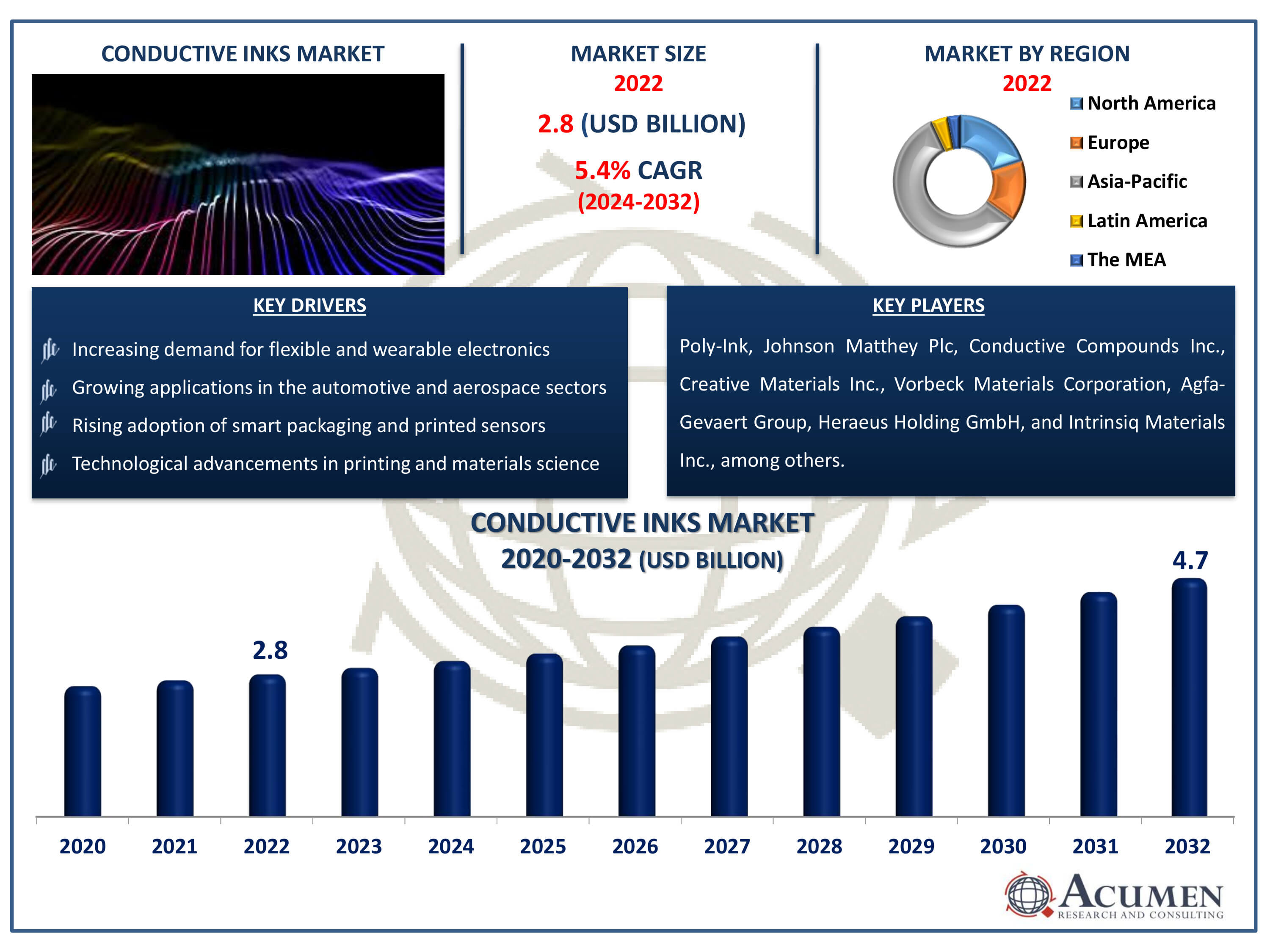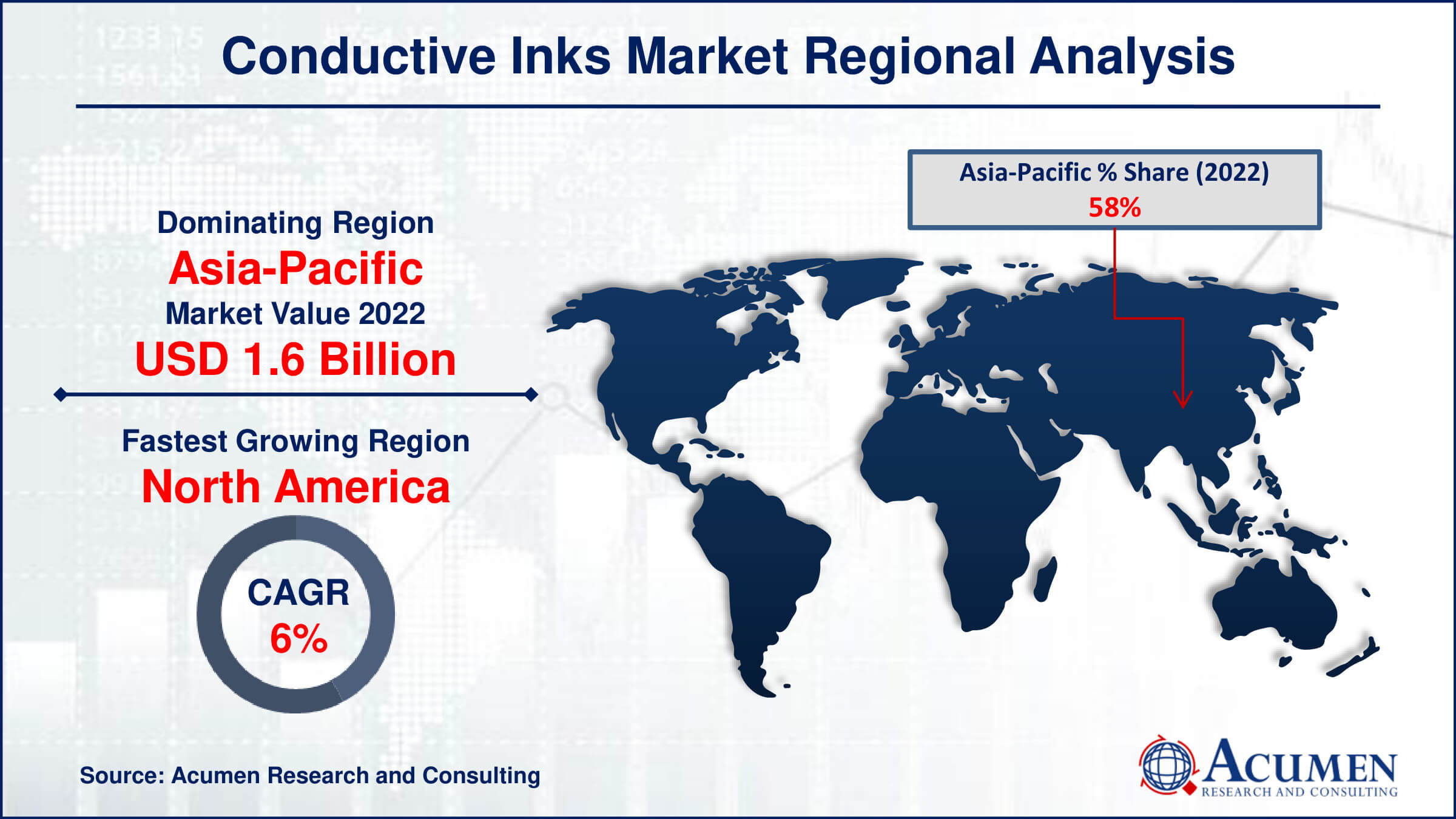Conductive Inks Market | Acumen Research and Consulting
Conductive Inks Market Size - Global Industry, Share, Analysis, Trends and Forecast 2024 - 2032
Published :
Report ID:
Pages :
Format : ![]()
The Conductive Inks Market Size accounted for USD 2.8 Billion in 2022 and is estimated to achieve a market size of USD 4.7 Billion by 2032 growing at a CAGR of 5.4% from 2024 to 2032.
Conductive Inks Market Highlights
- Global conductive inks market revenue is poised to garner USD 4.7 billion by 2032 with a CAGR of 5.4% from 2024 to 2032
- Asia-Pacific conductive inks market value occupied around USD 1.6 billion in 2022
- North America conductive inks market growth will record a CAGR of more than 6% from 2024 to 2032
- Among type, the silver conductive inks sub-segment generated around USD 588 million revenue in 2022
- Based on application, the photovoltaic sub-segment generated more than 22% conductive inks market share in 2022
- Increasing research into new conductive materials and nanotechnologies is a popular conductive inks market trend that fuels the industry demand

Conductive inks are specialized formulations made up of conductive elements like silver, carbon, or copper particles suspended in a liquid medium or binder. These inks are intended to conduct electricity, making them useful in a variety of electronic and electrical applications. When conductive inks are put to a surface and cured, they form a thin, flexible conductive coating that may be printed to build electrical circuits, antennas, sensors, and other electronic components. Conductive inks provide various advantages, including the ability to print on flexible substrates, compatibility with a variety of printing processes (including screen and inkjet printing), and the possibility for cost-effective electrical device fabrication. They are critical components in new technologies like as wearable electronics, printed circuit boards, and flexible screens.
Global Conductive Inks Market Dynamics
Market Drivers
- Increasing demand for flexible and wearable electronics
- Growing applications in the automotive and aerospace sectors
- Rising adoption of smart packaging and printed sensors
- Technological advancements in printing and materials science
Market Restraints
- High production costs for advanced conductive ink formulations
- Limited compatibility with existing printing processes
- Regulatory and environmental concerns regarding some conductive materials
Market Opportunities
- Expansion into emerging markets with growing electronics industries
- Development of eco-friendly conductive inks
- Growth in applications for 3D printing technologies
Conductive Inks Market Report Coverage
| Market | Conductive Inks Market |
| Conductive Inks Market Size 2022 | USD 2.8 Billion |
| Conductive Inks Market Forecast 2032 |
USD 4.7 Billion |
| Conductive Inks Market CAGR During 2024 - 2032 | 5.4% |
| Conductive Inks Market Analysis Period | 2020 - 2032 |
| Conductive Inks Market Base Year |
2022 |
| Conductive Inks Market Forecast Data | 2024 - 2032 |
| Segments Covered | By Type, By Application, And By Geography |
| Regional Scope | North America, Europe, Asia Pacific, Latin America, and Middle East & Africa |
| Key Companies Profiled | Poly-Ink, Johnson Matthey Plc, Conductive Compounds Inc., Creative Materials Inc., Vorbeck Materials Corporation, Agfa-Gevaert Group, Heraeus Holding GmbH, Intrinsiq Materials Inc., DuPont, Sun Chemical Corporation, NovaCentrix, and Henkel AG & Co. KGaA. |
| Report Coverage |
Market Trends, Drivers, Restraints, Competitive Analysis, Player Profiling, Covid-19 Analysis, Regulation Analysis |
Conductive Inks Market Insights
The increasing number of advancements in printed electronics is expected to drive the global industry during the conductive inks market forecast period. Furthermore, the rising demand for conductive inks from industries such as healthcare and electronics and electricals (E&E) supports the market's growth globally. Additionally, the growing preference for miniaturized electronic devices promotes the expansion of the global conductive inks market. However, challenges associated with high-end technologies may hinder the global conductive inks market in the coming years. Nonetheless, the growing use of 3D printing technology in medical devices and various other applications is expected to offer significant growth opportunities for manufacturers in the conductive ink industry forecast period. Printed devices can be used in a wide range of applications, including organic photovoltaics (OPVs) and organic light-emitting diodes (OLEDs). As technology advances, various types of nano-engineering techniques have been developed to improve light extraction from OLEDs, such as nano-engraving and nano-contact printing. Additionally, the increasing demand for low-cost, anti-reflection coatings for use in the LCD market is driving the market.
Rising awareness of the usefulness and convenience of printed electronics across various industries is expected to boost the global conductive inks industry in the short, medium, and long term. The growing use of touchscreens, printed circuit boards (PCBs), antennas, circuits, biosensors, sensors, printed heaters, and touch switches in different industries also serves as a significant driving factor for the global conductive inks market. Medical-grade, electrically conductive inks are utilized in a wide range of medical electrode terminal applications, such as TENS and ECG electrode applications, transdermal drug delivery, defibrillation, and monitoring systems. The increasing use of conductive inks in advanced medical devices is acting as a key driving factor for the global conductive inks market.
Conductive Inks Market Segmentation
The worldwide market for conductive inks is split based on product, application, and geography.
Conductive Ink Market By Type
- Silver Conductive Inks
- Copper Conductive Inks
- Conductive Polymers
- Conductive Nanotube Inks
- Dielectric inks
- Graphene/Carbon Inks
According to conductive inks industry analysis, silver conductive inks are a prominent sector, renowned for producing the most revenue due to their outstanding conductive qualities and diverse applications. Silver is one of the most conductive metals, hence silver-based inks are extremely efficient in transmitting electric currents. This strong conductivity, along with outstanding stickiness and flexibility, makes silver conductive inks suitable for a wide range of electrical applications. One of the key reasons silver conductive inks dominate the market is their application in printed electronics, such as touchscreens, printed circuit boards (PCBs), and flexible electronic devices. Silver's excellent conductivity enables the design of complicated, efficient circuits required for contemporary electronics. Silver conductive inks are also widely employed in photovoltaics (solar cells) and organic light-emitting diodes (OLEDs), which need excellent efficiency and endurance.
In addition to their technological benefits, silver conductive inks are compatible with a variety of printing techniques, including screen printing, inkjet printing, and gravure printing, making them adaptable to many production processes. This compatibility, along with continuous technical improvements and an increasing need for lightweight, flexible electronics, is driving the silver conductive inks segment's market rise. Despite being more expensive than other conductive inks, silver conductive inks' performance benefits and broad application maintain them at the forefront of the industry, propelling them to the top revenue-generating area.
Conductive Ink Market By Application
- Photovoltaic
- Membrane switches
- Displays
- Automotive
- Smart packaging
- Biosensors
- Printed circuit boards
- Other applications
The photovoltaic category is the biggest application in the conductive inks market, owing to the growing need for renewable energy sources, notably solar power. Photovoltaic cells, commonly known as solar cells, rely on conductive inks to produce conductive channels that aid in the effective conversion of sunlight into energy. Silver-based conductive inks are widely utilised in the production of solar cells due to their high conductivity and outstanding performance in transferring electric currents. These inks serve as the solar cells' front and back contacts, allowing produced power to flow more freely. The great efficiency of silver conductive inks allows solar panels to function properly, making them an important component of the renewable energy sector.
As the world's focus on lowering carbon emissions and addressing climate change grows, so does demand for clean and sustainable energy sources such as solar power. This, in turn, increases demand for solar cells and, by extension, the conductive inks required in their manufacture. Furthermore, advances in solar technology, such as the creation of flexible and lightweight solar panels, have increased demand for conductive inks. These revolutionary solar gadgets have a wide range of uses, including portable electronics, building-integrated photovoltaics, and wearable solar devices.
Conductive Inks Market Regional Outlook
North America
- U.S.
- Canada
Europe
- U.K.
- Germany
- France
- Spain
- Rest of Europe
Asia-Pacific
- India
- Japan
- China
- Australia
- South Korea
- Rest of Asia-Pacific
Latin America
- Brazil
- Mexico
- Rest of Latin America
The Middle East & Africa
- South Africa
- GCC Countries
- Rest of the Middle East & Africa (ME&A)

Conductive Inks Market Regional Analysis
In terms of conductive inks market analysis, a number of major reasons contribute to Asia-Pacific's leading position in the Conductive Inks Market. China, Japan, South Korea, and Taiwan are among the region's major electronics manufacturing centers. These nations lead the way in the production of consumer electronics, cell phones, displays, and other high-tech products that rely significantly on conductive inks for components like touch screens, sensors, and printed circuit boards (PCBs).
While Asia-Pacific has the largest market size, North America is the fastest-growing area due to its strong technical innovation and early acceptance of new trends. The region's strong R&D skills drive advances in conductive ink formulations and applications, notably in cutting-edge fields like wearable electronics, flexible displays, and smart packaging.
Conductive Inks Market Players
Some of the top conductive inks companies offered in our report includes Poly-Ink, Johnson Matthey Plc, Conductive Compounds Inc., Creative Materials Inc., Vorbeck Materials Corporation, Agfa-Gevaert Group, Heraeus Holding GmbH, Intrinsiq Materials Inc., DuPont, Sun Chemical Corporation, NovaCentrix, and Henkel AG & Co. KGaA.
Frequently Asked Questions
How big is the conductive inks market?
The conductive inks market size was valued at USD 2.8 billion in 2022.
What is the CAGR of the global conductive inks market from 2024 to 2032?
The CAGR of conductive inks is 5.4% during the analysis period of 2024 to 2032.
Which are the key players in the conductive inks market?
The key players operating in the global market are including Poly-Ink, Johnson Matthey Plc, Conductive Compounds Inc., Creative Materials Inc., Vorbeck Materials Corporation, Agfa-Gevaert Group, Heraeus Holding GmbH, Intrinsiq Materials Inc., DuPont, Sun Chemical Corporation, NovaCentrix, and Henkel AG & Co. KGaA.
Which region dominated the global conductive inks market share?
Asia-Pacific held the dominating position in conductive inks industry during the analysis period of 2024 to 2032.
Which region registered fastest CAGR from 2024 to 2032?
North America region exhibited fastest growing CAGR for market of conductive inks during the analysis period of 2024 to 2032.
What are the current trends and dynamics in the global conductive inks industry?
The current trends and dynamics in the conductive inks industry include increasing demand for flexible and wearable electronics, growing applications in the automotive and aerospace sectors, rising adoption of smart packaging and printed sensors, and technological advancements in printing and materials science.
Which application held the maximum share in 2022?
The photovoltaic application held the maximum share of the conductive inks industry.


